Pricing and Coordination Strategies in a Dual Channel Supply Chain with Green Production under Cap and Trade Regulation
Abstract
1. Introduction
2. Literature
3. Problem Definition
4. Model Solutions and Discussions
4.1. Stackelberg Game
4.2. Cooperative Game
5. Computational Results and Analysis
6. Conclusions
Author Contributions
Funding
Institutional Review Board Statement
Informed Consent Statement
Data Availability Statement
Conflicts of Interest
Abbreviations
| Parameters | |
| Retailer’s channel demand for the green product | |
| Manufacturer’s channel demand for the green product | |
| α | Initial demand of the green product in case of free charge |
| Rate of customer preference to retailer’s channel | |
| Rate of customer preference to the manufacturer’s channel | |
| b | Marginal demand of each channel per their price |
| β | Green investment effectiveness per unit of green product |
| c | The regular unit production cost ($) |
| L | Limit of Carbon Emission (Cap) |
| t | Carbon trading price ($) |
| e | Carbon emission per unit of green product |
| k | Green cost coefficient |
| n | Value efficiency parameter |
| subscript r | Retailer |
| subscript m | Manufacturer |
| subscript and superscript s | Stackelberg game (competition) |
| subscript and superscript c | Cooperative game (cooperation) |
| DecisionVariables | |
| Price of traditional retailing channel ($) | |
| Price of online channel ($) | |
| g | Green rate of products (The Abatement Level) |
| w | Wholesale price ($) |
| Value added by the retailer ($) |
Appendix A
References
- Sarkis, J.; Zhu, Q.; Lai, K.-H. An organizational theoretic review of green supply chain management literature. Int. J. Prod. Econ. 2011, 130, 1–15. [Google Scholar] [CrossRef]
- Fahimnia, B.; Sarkis, J.; Davarzani, H. Green supply chain management: A review and bibliometric analysis. Int. J. Prod. Econ. 2015, 162, 101–114. [Google Scholar] [CrossRef]
- Xu, X.; He, P.; Xu, H.; Zhang, Q. Supply chain coordination with green technology under cap-and-trade regulation. Int. J. Prod. Econ. 2017, 183, 433–442. [Google Scholar] [CrossRef]
- Srivastava, S.K. Green supply-chain management: A state-of-the-art literature review. Int. J. Manag. Rev. 2007, 9, 53–80. [Google Scholar] [CrossRef]
- Gunasekaran, A.; Subramanian, N.; Rahman, S. Green supply chain collaboration and incentives: Current trends and future directions. Transp. Res. Part E Logist. Transp. Rev. 2015, 74, 1–10. [Google Scholar] [CrossRef]
- Dan, B.; Xu, G.; Liu, C. Pricing policies in a dual-channel supply chain with retail services. Int. J. Prod. Econ. 2012, 139, 312–320. [Google Scholar] [CrossRef]
- Li, B.; Zhu, M.; Jiang, Y.; Li, Z. Pricing policies of a competitive dual-channel green supply chain. J. Clean. Prod. 2016, 112, 2029–2042. [Google Scholar] [CrossRef]
- Du, S.; Ma, F.; Fu, Z.; Zhu, L.; Zhang, J. Game-theoretic analysis for an emission-dependent supply chain in a ‘cap-and-trade’ system. Ann. Oper. Res. 2011, 228, 135–149. [Google Scholar] [CrossRef]
- Du, S.; Zhu, J.; Jiao, H.; Ye, W. Game-theoretical analysis for supply chain with consumer preference to low carbon. Int. J. Prod. Res. 2014, 53, 3753–3768. [Google Scholar] [CrossRef]
- Sheu, J.-B. Bargaining framework for competitive green supply chains under governmental financial intervention. Transp. Res. Part E Logist. Transp. Rev. 2011, 47, 573–592. [Google Scholar] [CrossRef]
- Xu, A.; Hu, X.; Gao, S. Game Model between Enterprises and Consumers in Green Supply Chain of Home Appliance Industry. In Proceedings of the 2011 10th International Symposium on Distributed Computing and Applications to Business, Engineering and Science, Wuxi, China, 14–17 October 2011; pp. 96–99. [Google Scholar]
- Sikhar, B.; Gaurav, A.; Zhang, W.J.; Biswajit, M.; Tiwari, M.K. A decision framework for the analysis of green supply chain contracts: An evolutionary game approach. Expert Syst. Appl. 2012, 39, 2965–2976. [Google Scholar] [CrossRef]
- Savaskan, R.C.; Van Wassenhove, L.N. Reverse Channel Design: The Case of Competing Retailers. Manag. Sci. 2006, 52, 1–14. [Google Scholar] [CrossRef]
- Swami, S.; Shah, J. Channel coordination in green supply chain management. J. Oper. Res. Soc. 2013, 64, 336–351. [Google Scholar] [CrossRef]
- Ghosh, D.; Shah, J. A comparative analysis of greening policies across supply chain structures. Int. J. Prod. Econ. 2012, 135, 568–583. [Google Scholar] [CrossRef]
- Ghosh, D.; Shah, J. Supply chain analysis under green sensitive consumer demand and cost sharing contract. Int. J. Prod. Econ. 2015, 164, 319–329. [Google Scholar] [CrossRef]
- Zhang, C.-T.; Liu, L.-P. Research on coordination mechanism in three-level green supply chain under non-cooperative game. Appl. Math. Model. 2013, 37, 3369–3379. [Google Scholar] [CrossRef]
- Zhang, C.-T.; Wang, H.-X.; Ren, M. Research on pricing and coordination strategy of green supply chain under hybrid production mode. Comput. Ind. Eng. 2014, 72, 24–31. [Google Scholar] [CrossRef]
- Jaber, M.Y.; Glock, C.; El Saadany, A. Supply chain coordination with emissions reduction incentives. Int. J. Prod. Res. 2013, 51, 69–82. [Google Scholar] [CrossRef]
- Zhang, B.; Xu, L. Multi-item production planning with carbon cap and trade mechanism. Int. J. Prod. Econ. 2013, 144, 118–127. [Google Scholar] [CrossRef]
- Liu, B.; Holmbom, M.; Segerstedt, A.; Chen, W. Effects of carbon emission regulations on remanufacturing decisions with limited information of demand distribution. Int. J. Prod. Res. 2015, 53, 532–548. [Google Scholar] [CrossRef]
- Barzinpour, F.; Taki, P. A dual-channel network design model in a green supply chain considering pricing and transportation mode choice. J. Intell. Manuf. 2018, 29, 1465–1483. [Google Scholar] [CrossRef]
- Xu, X.; Zhang, W.; He, P.; Xu, X. Production and pricing problems in make-to-order supply chain with cap-and-trade regulation. Omega 2017, 66, 248–257. [Google Scholar] [CrossRef]
- Rahmani, K.; Yavari, M. Pricing policies for a dual-channel green supply chain under demand disruptions. Comput. Ind. Eng. 2019, 127, 493–510. [Google Scholar] [CrossRef]
- Yu, C.; Wang, C.; Zhang, S. Advertising cooperation of dual-channel low-carbon supply chain based on cost-sharing. Kybernetes 2019, 49, 1169–1195. [Google Scholar] [CrossRef]
- Qian, X.; Chan, F.T.; Zhang, J.; Yin, M.; Zhang, Q. Channel coordination of a two-echelon sustainable supply chain with a fair-minded retailer under cap-and-trade regulation. J. Clean. Prod. 2020, 244, 118715. [Google Scholar] [CrossRef]
- Zhang, G.; Cheng, P.; Sun, H.; Shi, Y.; Zhang, G.; Kadiane, A. Carbon reduction decisions under progressive carbon tax regulations: A new dual-channel supply chain network equilibrium model. Sustain. Prod. Consum. 2021, 27, 1077–1092. [Google Scholar] [CrossRef]
- Meng, Q.; Li, M.; Liu, W.; Li, Z.; Zhang, J. Pricing policies of dual-channel green supply chain: Considering government subsidies and consumers’ dual preferences. Sustain. Prod. Consum. 2021, 26, 1021–1030. [Google Scholar] [CrossRef]
- Taleizadeh, A.A.; Moshtagh, M.S.; Moon, I. Optimal decisions of price, quality, effort level and return policy in a three-level closed-loop supply chain based on different game theory approaches. Eur. J. Ind. Eng. 2017, 11, 486–525. [Google Scholar] [CrossRef]
- Taleizadeh, A.A.; Kalantary, S.S.; Cárdenas-Barrón, L.E. Pricing and Lot sizing for an EPQ Inventory Model with Re-work and Multiple Shipments. TOP 2016, 24, 143–155. [Google Scholar] [CrossRef]
- Taleizadeh, A.A.; Noori-Daryan, M. Pricing, Replenishments and Production Policies in a Supply Chain of Pharmaco-logical Product with Rework Process: A Game Theoretic Approach. Oper. Res. Int. J. 2016, 16, 89–115. [Google Scholar] [CrossRef]
- Taleizadeh, A.A.; Niaki, S.T.A.; Hosseini, V. Optimizing Multi Product Multi Constraints Bi-objective Newsboy Problem with discount by Hybrid Method of Goal Programming and Genetic Algorithm. Eng. Optim. 2009, 41, 437–457. [Google Scholar] [CrossRef]
- Taleizadeh, A.A.; Cárdenas-Barrón, L.E.; Biabani, J.; Nikousokhan, R. Multi products single machine EPQ model with immediate rework process. Int. J. Ind. Eng. Comput. 2012, 3, 93–102. [Google Scholar] [CrossRef]
- Sundarakani, B.; de Souza, R.; Goh, M.; Wagner, S.M.; Manikandan, S. Modeling carbon footprints across the sup-ply chain. Int. J. Prod. Econ. 2010, 128, 43–50. [Google Scholar] [CrossRef]
- Sim, S.; Jung, H. Green Investment Cost Optimization Model in the Supply Chain. Am. J. Oper. Res. 2013, 3, 454–462. [Google Scholar] [CrossRef][Green Version]
- Wang, X.J.; Choi, S.H. Impacts of carbon emission reduction mechanisms on uncertain make-to-order manufacturing. Int. J. Prod. Res. 2015, 54, 3311–3328. [Google Scholar] [CrossRef]
- Singham, D.I.; Cai, W.; White, J.A. Optimal carbon capture and storage contracts using historical CO2 emissions levels. Energy Syst. 2015, 6, 331–360. [Google Scholar] [CrossRef][Green Version]
- Bazan, E.; Jaber, M.Y.; Zanoni, S. Supply chain models with greenhouse gases emissions, energy usage and different coordination decisions. Appl. Math. Model. 2015, 39, 5131–5151. [Google Scholar] [CrossRef]
- Xu, X.; Xu, X.; He, P. Joint production and pricing decisions for multiple products with cap-and-trade and carbon tax regulations. J. Clean. Prod. 2016, 112, 4093–4106. [Google Scholar] [CrossRef]
- Liu, M.; Cao, E.; Salifou, C.K. Pricing strategies of a dual-channel supply chain with risk aversion. Transp. Res. Part E Logist. Transp. Rev. 2016, 90, 108–120. [Google Scholar] [CrossRef]
- Mukhopadhyay, S.K.; Yao, D.-Q.; Yue, X. Information sharing of value-adding retailer in a mixed channel hi-tech supply chain. J. Bus. Res. 2008, 61, 950–958. [Google Scholar] [CrossRef]
- Liu, H.; Kou, X.; Xu, G.; Qiu, X.; Liu, H. Which emission reduction mode is the best under the carbon cap-and-trade mechanism? J. Clean. Prod. 2021, 314, 128053. [Google Scholar] [CrossRef]

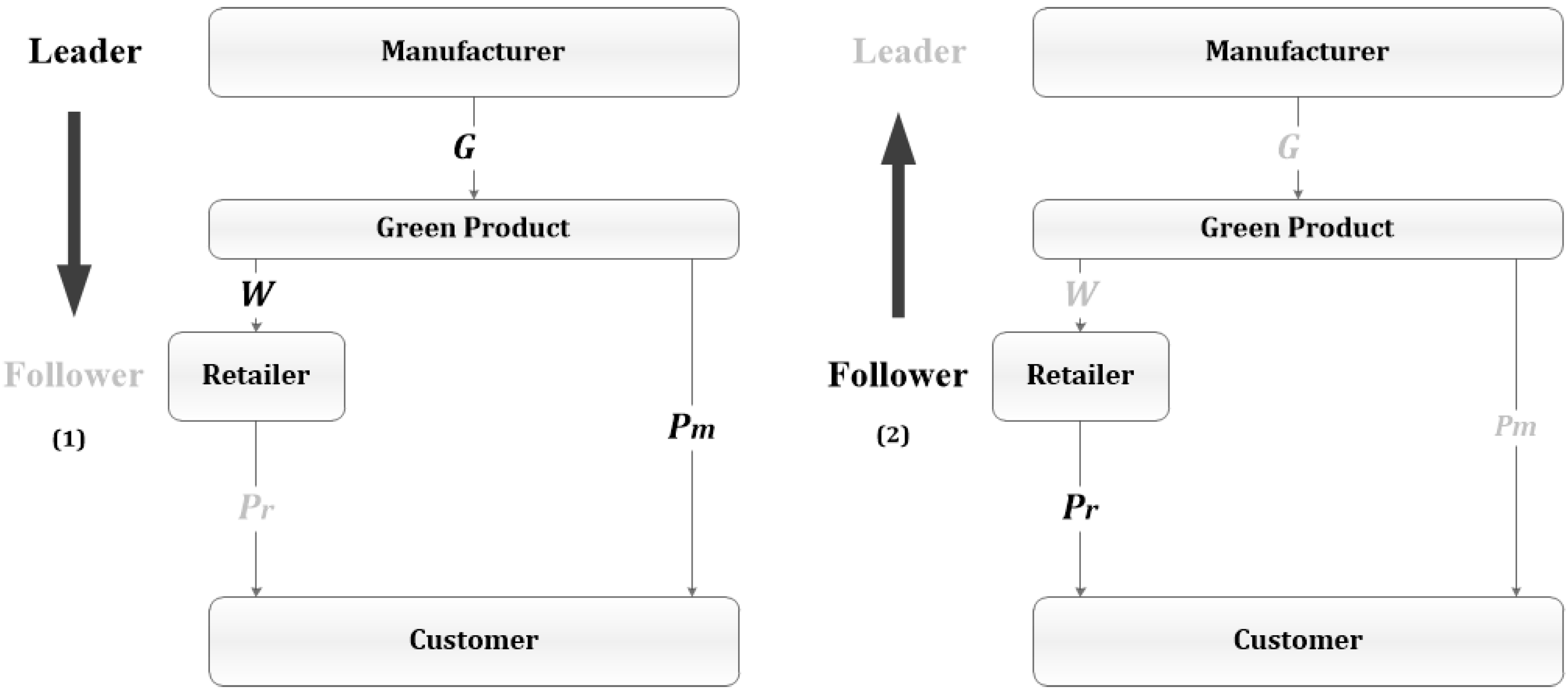
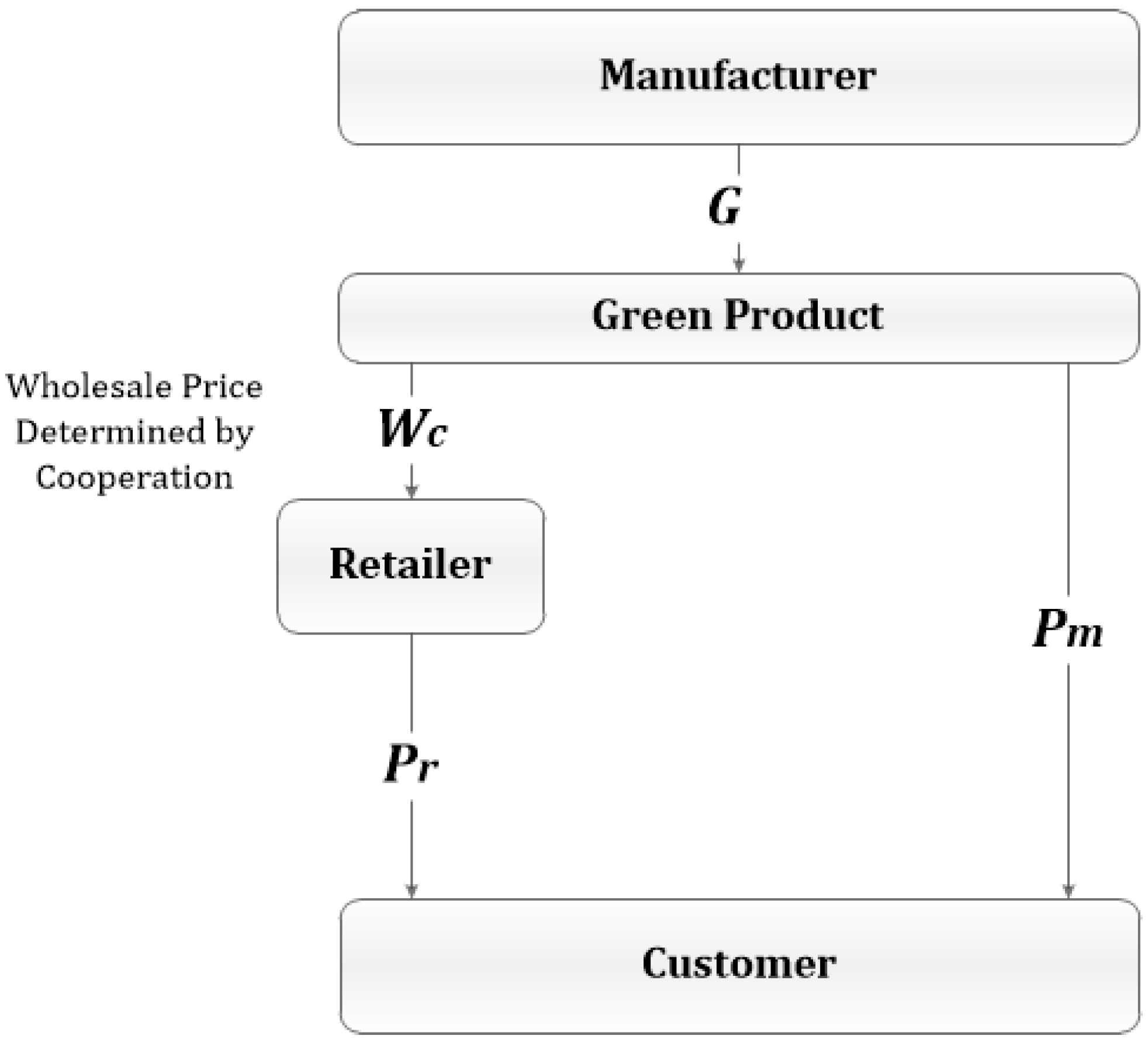
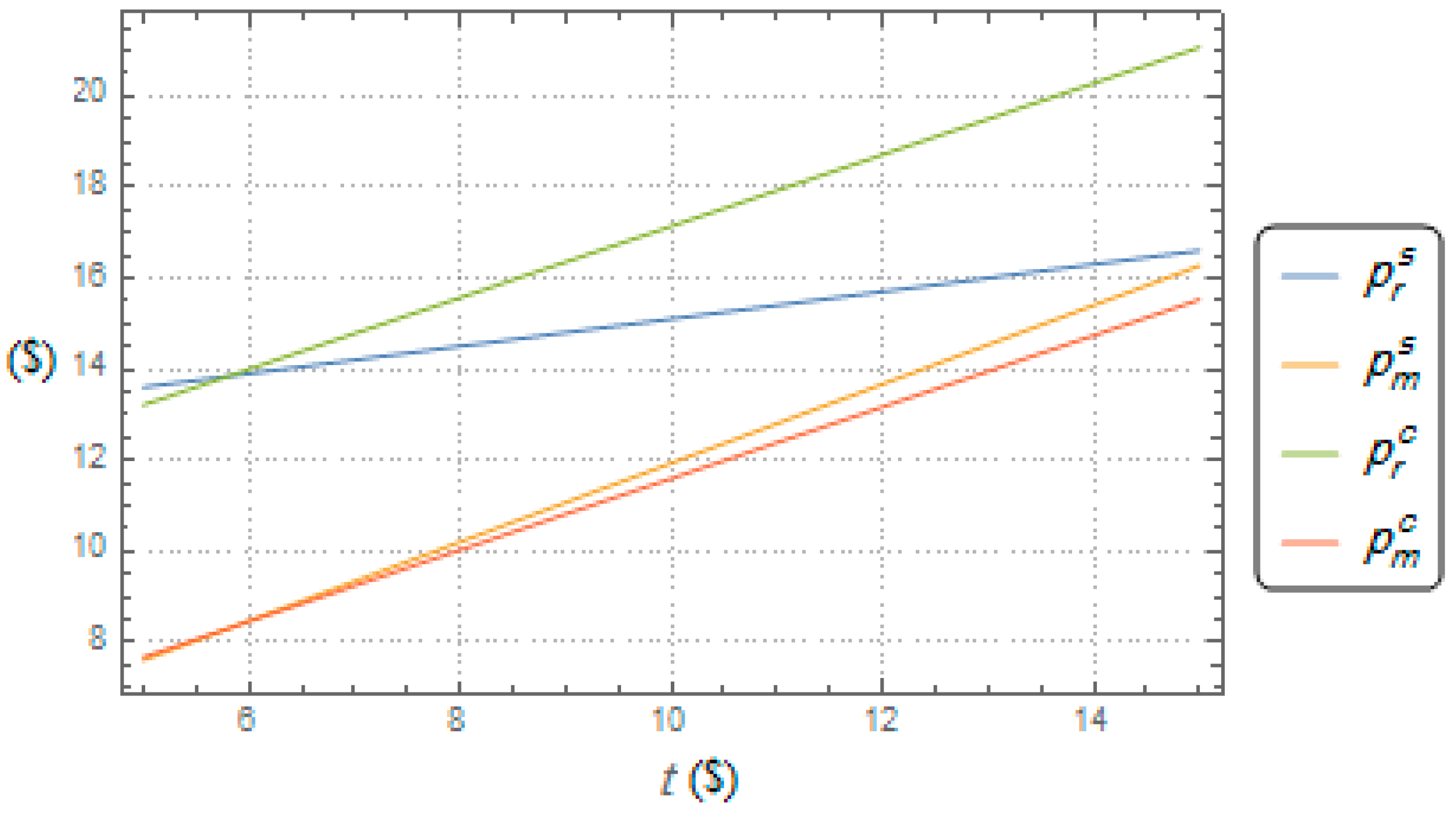
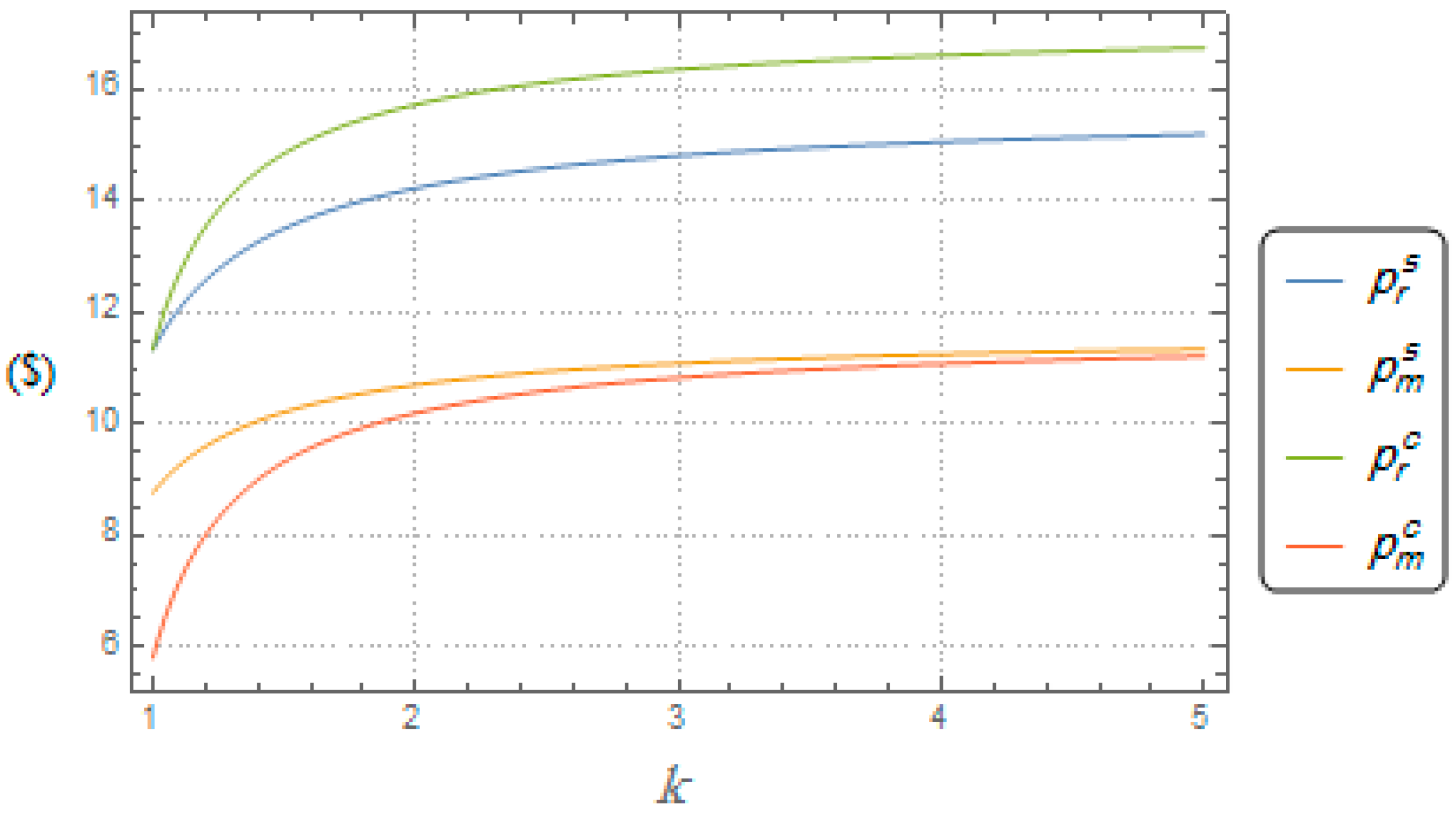


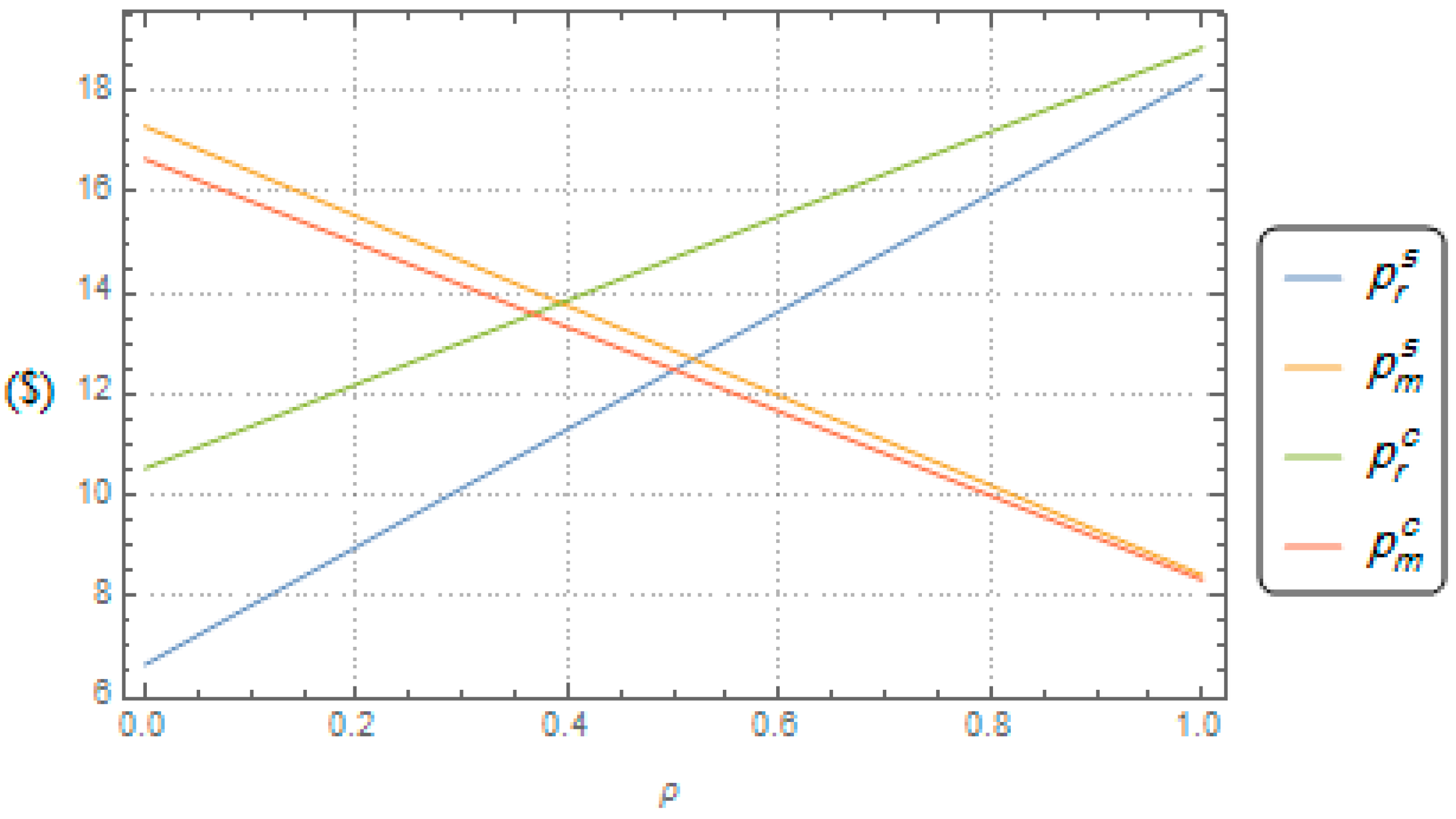
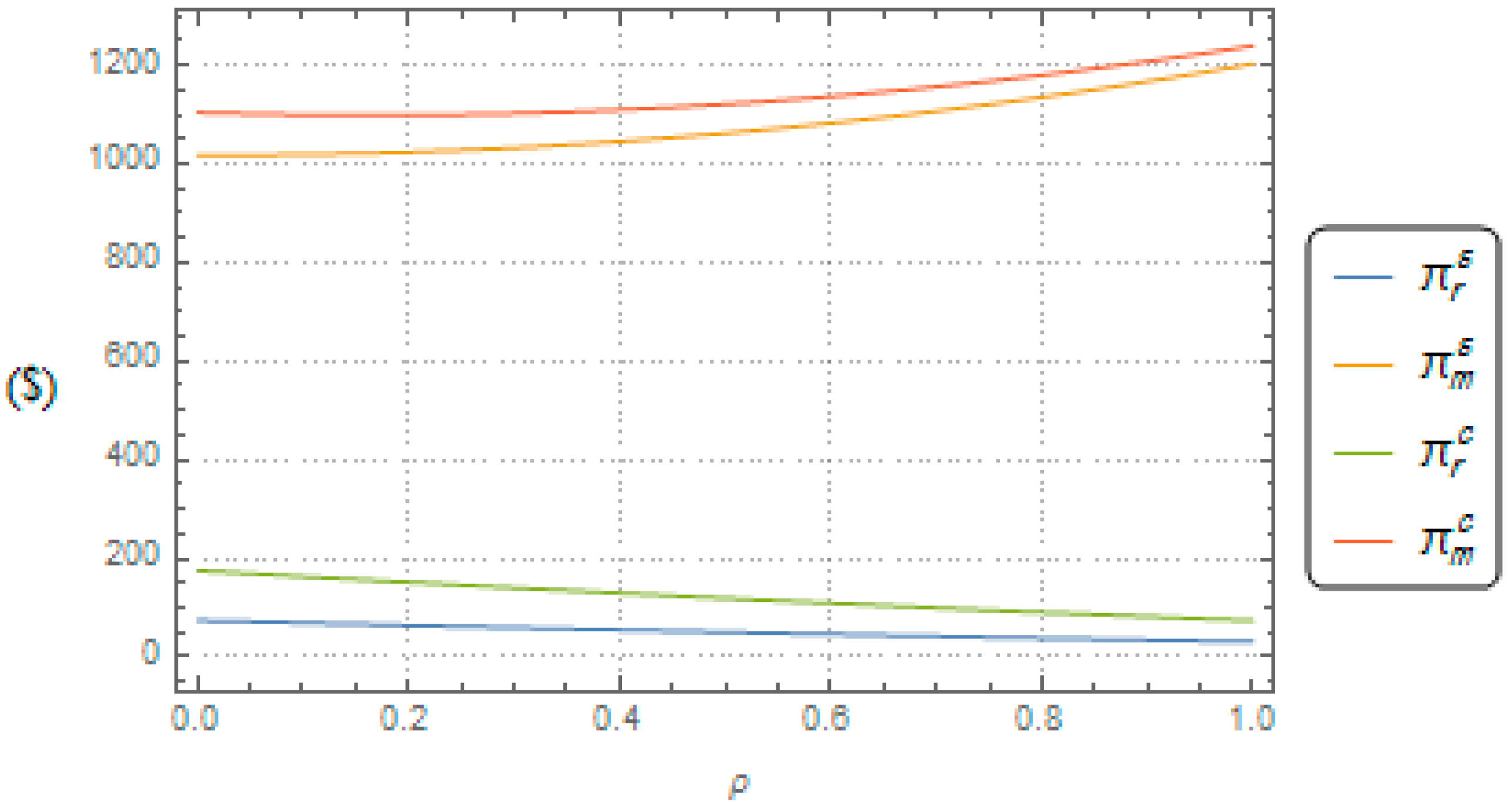
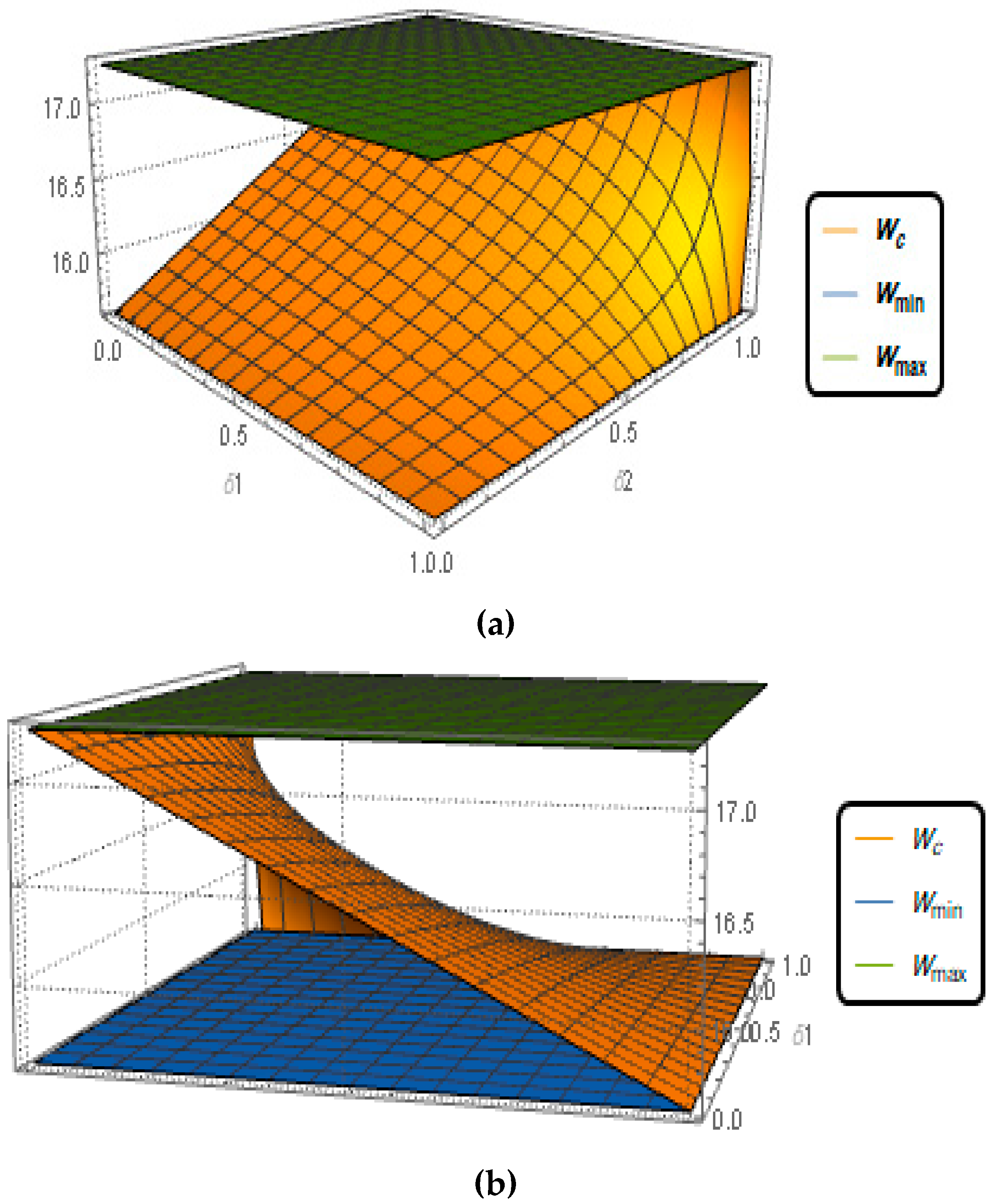
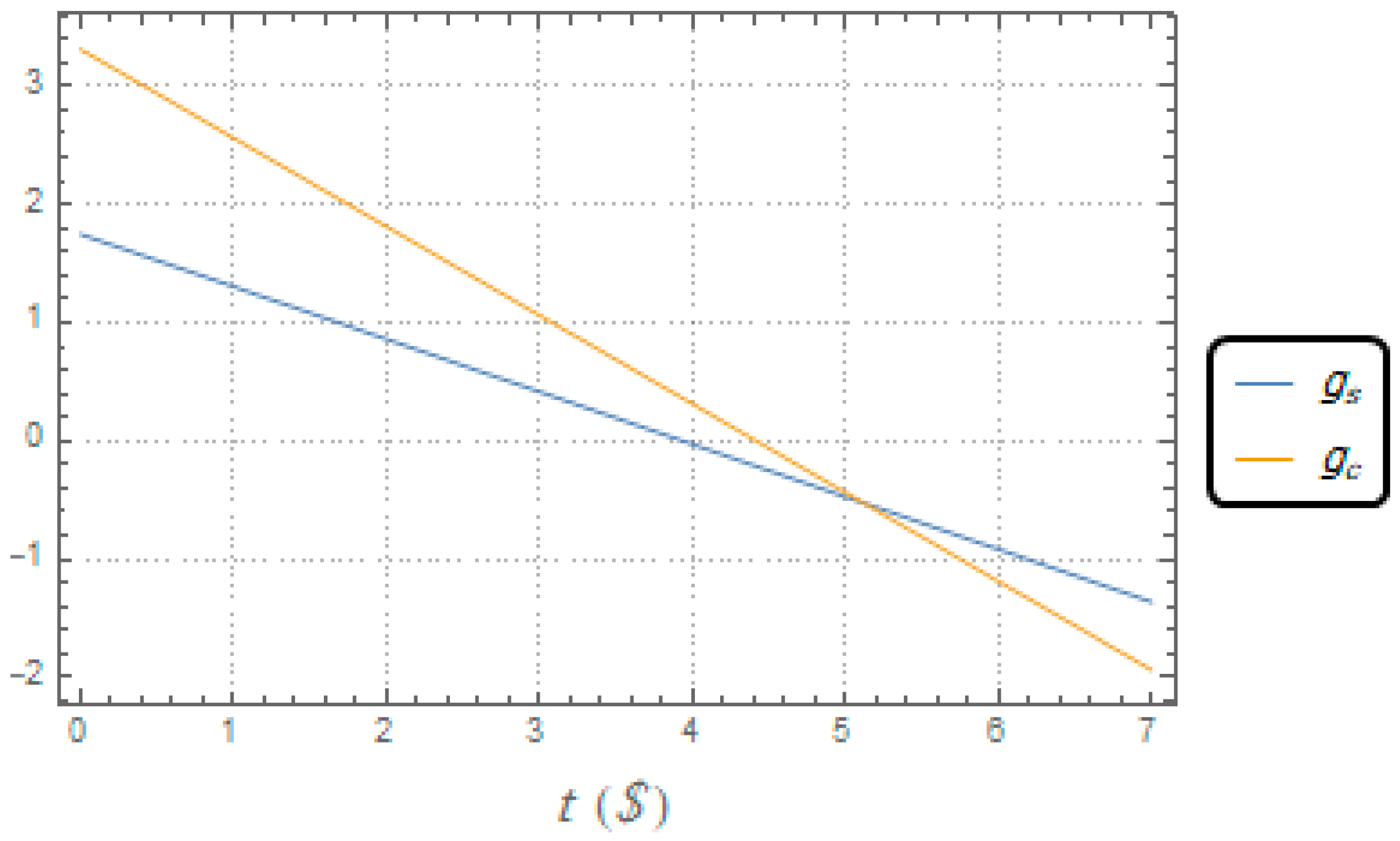
| Author | Decision Type | Carbon Related Context | Game | Coordination | Additional Info | |||||||||
|---|---|---|---|---|---|---|---|---|---|---|---|---|---|---|
| Production | Pricing | Coordination | Inventory | Carbon Capacity | Carbon Penalty | Cap and Trade | Emission Reduction | Carbon Tax | Carbon Footprint | Other | ||||
| (Sundarakani et al. 2010) [34] | ✓ | |||||||||||||
| (Du et al. 2011) [8] | ✓ | ✓ | ✓ | Stackelberg | ||||||||||
| (Jaber et al. 2013) [19] | ✓ | ✓ | Emission reduction incentives | |||||||||||
| (Zhang and Xu 2013) [20] | ✓ | ✓ | Multi item | |||||||||||
| (Sim and Jung 2013) [35] | ✓ | ✓ | ✓ | Green investment | Transportation | |||||||||
| (Du et al. 2014) [9] | ✓ | ✓ | ✓ | Consumer preference | Non-cooperative | Wholesale price, revenue sharing, quantity discount | ||||||||
| (Liu et al. 2014) [21] | ✓ | ✓ | ✓ | ✓ | ✓ | ✓ | Remanufacturing | |||||||
| (Wang and Choi 2015) [36] | ✓ | ✓ | ✓ | MTO, uncertainty | ||||||||||
| (Singham et al. 2015) [37] | Carbon capture and storage contract | Multiple emitter | ||||||||||||
| (Bazan et al. 2015) [38] | ✓ | ✓ | ✓ | ✓ | ✓ | Energy usage & ghg emission | ||||||||
| (Xu et al. 2016) [39] | ✓ | ✓ | ✓ | ✓ | Multi-products | |||||||||
| (Barzinpour and Taki 2016) [22] | ✓ | Carbon efficiency in Transportation | ||||||||||||
| (Xu et al. 2017) [39] | ✓ | ✓ | ✓ | Make to order | ||||||||||
| (Xu et al. 2017) [23] | ✓ | ✓ | Green technology | Stackelberg | Cost sharing | |||||||||
| (Rahmani et al. 2019) [24] | ✓ | ✓ | Green product | Stackelberg | ||||||||||
| (Yu et al. 2019) [25] | ✓ | ✓ | Stackelberg | Cost sharing | ||||||||||
| (Qian et al. 2020) [26] | ✓ | ✓ | ✓ | Wholesale price, two-part tariff, Nash & Rubinstein bargaining | ||||||||||
| (Zhang et al. 2021) [27] | ✓ | ✓ | Variational inequality theory | |||||||||||
| (Meng et al. 2021) [28] | ✓ | Green product | Stackelberg | |||||||||||
| This Paper | ✓ | ✓ | ✓ | ✓ | ✓ | Green production | Stackelberg & cooperative | Cooperative pricing | Value adding retailer | |||||
Publisher’s Note: MDPI stays neutral with regard to jurisdictional claims in published maps and institutional affiliations. |
© 2021 by the authors. Licensee MDPI, Basel, Switzerland. This article is an open access article distributed under the terms and conditions of the Creative Commons Attribution (CC BY) license (https://creativecommons.org/licenses/by/4.0/).
Share and Cite
Taleizadeh, A.A.; Shahriari, M.; Sana, S.S. Pricing and Coordination Strategies in a Dual Channel Supply Chain with Green Production under Cap and Trade Regulation. Sustainability 2021, 13, 12232. https://doi.org/10.3390/su132112232
Taleizadeh AA, Shahriari M, Sana SS. Pricing and Coordination Strategies in a Dual Channel Supply Chain with Green Production under Cap and Trade Regulation. Sustainability. 2021; 13(21):12232. https://doi.org/10.3390/su132112232
Chicago/Turabian StyleTaleizadeh, Ata Allah, Milad Shahriari, and Shib Sankar Sana. 2021. "Pricing and Coordination Strategies in a Dual Channel Supply Chain with Green Production under Cap and Trade Regulation" Sustainability 13, no. 21: 12232. https://doi.org/10.3390/su132112232
APA StyleTaleizadeh, A. A., Shahriari, M., & Sana, S. S. (2021). Pricing and Coordination Strategies in a Dual Channel Supply Chain with Green Production under Cap and Trade Regulation. Sustainability, 13(21), 12232. https://doi.org/10.3390/su132112232







